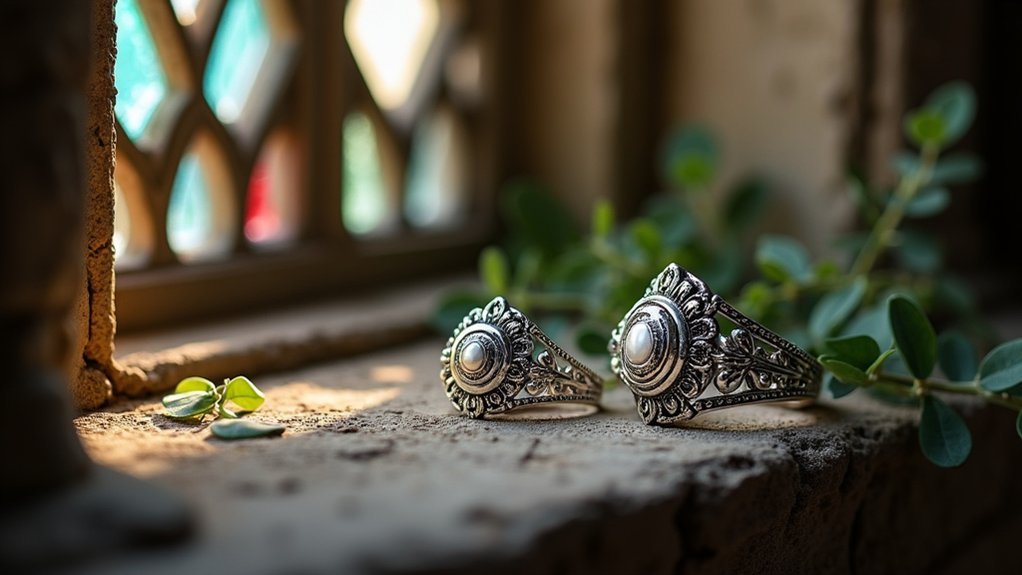When creating cathedral settings in silver jewelry, you’ll need to master three essential techniques. First, choose the right cathedral height by balancing gemstone visibility with practical wearability for your client’s lifestyle. Second, secure your stone with four to six properly curved prongs that cradle the gemstone without snagging fabric. Third, construct cathedral arches with sufficient thickness and proper weight distribution using well-alloyed silver for lasting durability. These fundamentals will elevate your craftsmanship considerably.
Choose the Right Cathedral Height for Your Silver Ring Design

When choosing cathedral height for your silver ring design, you’ll want to balance aesthetics with practicality. Elevated settings dramatically enhance the visibility of the central gemstone while increasing the perceived size of your stone, creating an elegant and timeless appearance.
Consider your lifestyle when selecting height. Higher settings offer superior security for the diamond but may catch on clothing. A petite cathedral height creates a delicate look that’s perfect for smaller hands while still showcasing your central stone effectively.
Higher cathedral settings provide enhanced diamond security but may snag on fabric, while petite heights offer delicate elegance for smaller hands.
Medium cathedral height provides the ideal compromise between elegance and everyday wearability.
Don’t forget compatibility with wedding bands. Higher cathedral settings typically allow rings to sit flush together, ensuring your engagement and wedding rings complement each other perfectly for years to come.
Secure Your Gemstone With Proper Prong Placement Techniques
Proper prong placement forms the foundation of a secure cathedral setting, guaranteeing your precious gemstone remains safely in place while maximizing its visual impact.
Position four to six prongs at equal distances around your stone to achieve ideal stability. Create a slight curve in each prong to cradle the gemstone securely while maintaining maximum light exposure for enhanced brilliance.
Check your prong placement regularly for wear signs, as minor shifts can compromise security. Consider the height carefully—prongs should elevate stone sufficiently without catching on clothing.
Maintain proper alignment with the stone’s center to guarantee balanced design appeal. The metal rim formed by well-positioned prongs creates both functional support and aesthetic enhancement, making your cathedral setting both beautiful and durable.
Balance Aesthetics and Durability in Cathedral Arch Construction

Beyond securing your gemstone with well-positioned prongs, the cathedral arches themselves demand careful attention to both form and function.
You’ll need sufficient thickness in your cathedral settings to maintain structural integrity while preserving their elegant silhouette. The height of the arch requires careful consideration—too tall and you’ll catch on objects, too short and you’ll lose visual impact.
Focus on weight distribution across the arches to prevent strain and bending. Choose properly alloyed silver that enhances durability without sacrificing aesthetic appeal. Your design elements should spread stress evenly, protecting your central stone and ensuring longevity.
Proper weight distribution and quality silver alloy ensure cathedral arches resist strain while maintaining their elegant aesthetic and protective function.
Regularly inspect your cathedral arches for signs of wear or damage. Maintaining their shape isn’t just about looks—it’s essential for keeping your gemstone secure.
Frequently Asked Questions
What Are the Pros and Cons of Cathedral Setting Ring?
Cathedral settings elevate your diamond beautifully and provide excellent protection, but you’ll deal with higher maintenance needs and potential snagging on clothing due to their raised profile design.
Is the Cathedral Setting Outdated?
Cathedral settings aren’t outdated at all. You’ll find they’re timeless classics that blend beautifully with both traditional and modern styles. They’re versatile enough to accommodate various diamond shapes while maintaining their architectural elegance.
What Is the Difference Between Tiffany and Cathedral Setting?
You’ll find Tiffany settings use six prongs elevating diamonds for maximum brilliance, while cathedral settings feature architectural arches supporting stones. Tiffany’s more expensive with brand prestige; cathedral’s more customizable and affordable.
What Is the Difference Between Pave and Cathedral Setting?
You’ll find pave settings feature multiple small diamonds set closely together for continuous sparkle, while cathedral settings elevate a single central stone on arched supports for enhanced prominence and visibility.
In Summary
You’ll create stunning cathedral setting silver jewelry by mastering these three essential techniques. Don’t forget to measure your cathedral height carefully to complement your ring’s proportions. You’re ensuring longevity when you position prongs strategically around your gemstone. Most importantly, you’re achieving that perfect balance between visual appeal and structural integrity in your cathedral arches. These fundamentals will help you craft professional-quality pieces that’ll stand the test of time and showcase your gemstones beautifully.





Leave a Reply